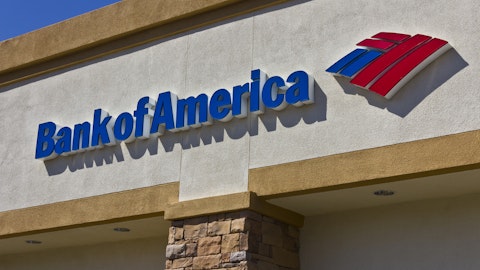Katie Murray: Sure. Thanks very much, Paul. So if we look at the hedge, the notional balance, as you know, at the end of the third quarter £195 billion down from £202 billion at the end of June. Based on our expectation for deposit mix at the end of 2023 and our 12-month loopback, we expect the hedge notional to reduce to around £190 billion at the end of 2023 and then a further reduction in 2024, in line with the fall in the average eligible balances. As you know, Aman, 60th story of the hedge matures at each month, currently equivalent to around £10 billion per quarter. The roll-off of the hedge yield is about around 1% in the fourth quarter, falling to an average of 80 basis points in 2024 and then 50 basis points in 2025.
We will continue to reinvest them at the prevailing five-year swap rate. I would say that the average that we had in October for reinvestment was around 4.6%. So clearly the difference between roll-off and roll-on rates with the increase in yield over time, which was at 1.5% in Q3 is a benefit. We do expect the higher rate to — lead to higher hedge income year-on-year in 2024 and increasingly so in 2025 as we talked about at the half year. I think one of the key factors within there is obviously the timing of the stabilization of deposits and in terms of the mix of those deposits. Clearly quicker stabilization means that the benefit of the hedge will become greater and it will come to us sooner. Currently, our estimation is that we will start to see stabilization sort of during Q2 next year.
Aman, hopefully that answers your question. Thanks very much.
Paul Thwaite: Thanks, Aman.
Aman Rakkar: Thank you.
Operator: Our next question comes from Ed Firth of KBW. Ed, if you’d like to unmute and ask your question.
Katie Murray: Hi, Ed.
Ed Firth: Yes. Thanks very much, and good morning, everybody. I just have two questions. The first one was about your comments around expectations for deposit pricing to ease or deposit pressures to ease. Because if I look at market pricing, I mean, spreads on deposits now are at almost all-time highs. And the only reason it’s not coming through in your margin is obviously because of the hedge drag. I mean, if a hedge was re-priced at today’s price, your margin would be like 450 basis points or something. So it seems to me in a market where you got a lot of competitors who don’t have these hedges and you can think of people like Chase or Marcus, et cetera, I don’t understand why you think that they’re going to be easing off the pedal in order to help you with your hedge.
It seems to me that if you put in things like TFSME coming through as well, that the pressure is only going to build because by spreads are very, very wide for people who don’t have a hedge. So I guess that’s my first question. And the second question, I was just struck that in terms of risk weighted assets, you highlighted that the increase in this quarter was driven by market related risk weighted assets. And I’m just wondering, is that like a strategic shift? Because it seems to me you’re making a trade-off there in terms of share buybacks, which look reasonably unlikely now at the year-end against putting capital into market based activities, which I suspect has not traditionally been where you’ve been focused and is perhaps something that I guess a number of shareholders would be less than keen on.
So I just wondered, is that — is that now an area where you see opportunity and is that the sort of trade-off that you’re thinking in terms of capital allocation? Thanks very much.
Paul Thwaite: Thanks, Ed. I’ll take the second point and be very clear. It doesn’t represent any change in strategy around our markets business at all. All that is a normalization in quarter three, given there were some significant reductions in quarter two. So it’s really the comparison point. It has gone up, as Katie rightly said, but it’s more a normalization of where that business was earlier in the year. Absolutely no change. We see markets as an important part of our C&I franchise, but we’re not proposing to allocate materially more capital to it at this stage.
Ed Firth: Would you expect it to go down in Q4 like I mean traditionally it’s quite a low activity, is that correct?
Paul Thwaite: Correct. Yes, that would be our expectation.
Ed Firth: Great. Thanks.
Katie Murray: Lovely. Thanks very much, Ed. So I think, first of all, just to clarify is, I don’t think that competition will ease. We think that the transition into fix will start to ease and stabilize. So I do expect the deposit market to remain to be highly competitive as we move forward from here. And I think the impact of TFSME, as we’ve seen with some of our competitors over the summer will cause people to do very short-term offers to enable them to make repayments on their TFSME. I think we’ll continue to see that as we go through. I would probably just quickly remind you that the hedge is there to help smooth out our income over a number of years. It’s not there to make short-term gains and losses on the interest rate levels.
I think that’s really important to remember. We did show you on Slide 9 that we’re paying customers on average 2.7% on interest bearing deposits and 1.8% on all deposits. I think I would remind you that we’re not earning the difference between 1.8% and the average base rate of 5.2% because of how and we hedge that and how that all kind of interacts. But as I look forward from here, I think we’ve taken some very strategic action in this quarter to make sure that we retain and build our deposit base for the long-term so that we’re able to withstand what I do think will be very competitive next 9 months to 12 months as people deal with the repayments and things on their TFSME. But we’re comfortable with where we are and that we’ve got the right product out in the market to deal with that.
Thanks, Ed.
Ed Firth: Katie, can I just come back on that?
Katie Murray: Sure.
Ed Firth: As we look at Q4, we can all do the math about where the Q4 margin will end up, but I guess it’s somewhere in the 2.80, 2.90 level. But I guess more importantly, what happens next year, because the question is certainly talking to your peers, that they’re generally talking about margins going down from there into next year, which is obviously a huge difference to where the market thought early this morning your margin was going to be next year. So is that analysis correct for you that that margin we should expect to continue to deteriorate next year because deposit pricing is only getting tougher, not easier, and obviously the roll-off of the hedge is going to take five years?
Katie Murray: Yes. I think there’s a couple of things going on within there. So as I look, Ed, I’m not a big fan of forecasting NIM as you know.
Ed Firth: None of us are now.




